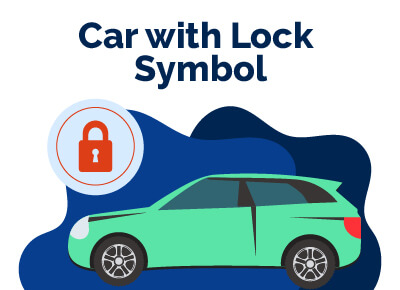Car With Lock Symbol (Key Causes & Fixes)
July 23, 2023
car batteries are operational


Chris is Head of Content for FindTheBestCarPrice and is based out of Philadelphia, PA. As a seasoned automotive industry analyst and car enthusiast, he ensures the highest level of quality across all our content and curates our picks for the best deals each month.
Chris studied information systems and marketing at Drexel University and writes about a wide range of topics ranging from car buying tips to troubleshooting common mechanical issues.
When he’s not thinking about cars, he likes to stay in with his dog and make an “attempt” to finish a crossword puzzle (he’s not quite at the Saturday/Sunday level…yet). As a former cheesemonger, Chris still has a “sharp” passion for all things cheese, and his fridge is always loaded with it!
Chris also has a passion for things that go fast, and drones are no exception. He spends some of his time writing for Dronesourced.
Dashboard indicators are indispensable for an optimal driving experience. These symbols enable the driver to monitor the status of various components of the vehicle's systems.
For example, a car that displays a lock symbol on its dashboard indicates that the anti-theft system has been triggered.
This guide assesses the significance of the lock symbol on the dashboard. We outline the leading causes of the warning and provide valuable tips to assist in resolving the issue.
Furthermore, you will learn more about the indications of a faulty anti-theft system, why your car exhibits a lock symbol, and the implications of a car with a lock symbol appearing on your dashboard.
So, come with us as we discuss the lock symbol on a car and enlighten you on the causes as well as what to do about it!
Table of Contents
What Does a Car With Lock Symbol Mean?
The display of a lock symbol on a car signifies that the security mechanism is engaged. The primary function of this mechanism is to augment security and thwart unauthorized access to the vehicle.
Should any attempts be made to purloin the car or gain entry without the proper key, the dashboard will indicate this with the flashing of both the car symbol and the lock symbol.
Nonetheless, the security system may also be activated without any attempted theft.
As a result, it is essential to conduct a thorough diagnostic procedure to identify the underlying source of the problem.
How To Fix a Car With a Lock Symbol
Numerous factors can catalyze for a car to exhibit a lock symbol; consequently, various methods can be employed to rectify the issue.
Here are some probable remedies for resolving the appearance of a lock symbol on the dashboard of various car models:
1. Inspect the Key Fob
Commence by examining your key Fob's battery status and ensuring it is functioning optimally.
If it is faulty, the key Fob is likely the culprit. Additionally, confirm that the battery is installed correctly, as this can be a probable cause of the problem.
Proceed to scrutinize the ignition cylinder. If there is evidence of a break-in attempt or any damage to the lock cylinder, it may trigger the anti-theft security mechanism.
Car thieves typically endeavor to purloin vehicles by forcing screwdrivers into the lock cylinder. Consequently, ensuring no discernible imperfections or abrasions on the cylinders is imperative.
When there is a damaged lock on the driver's door, it is advisable to utilize a physical key to unlock and lock the doors from the passenger's side.
This can help to clear the anti-theft warning on the dashboard. Lastly, ensure that you employ the appropriate key to start the car.
Some vehicles are equipped with valet keys that can only be used to lock and unlock the doors, but they lack the necessary chip to initiate the car's ignition system.
2. Unlock the Doors With a Physical Key
To gain access to the vehicle, utilize a physical key to unlock the car doors. In the case of keyless entry systems, examine the key Fob and slide the switch on it to reveal the concealed physical key. Subsequently, insert the key into the driver's door latch and turn it to unlock it.
After unlocking the door, refrain from opening it immediately. Allow the key to remain unlocked for approximately 30 to 45 seconds.
This will enable the vehicle's security system to recognize that the correct key is being utilized. However, it is essential to note that different vehicles operate differently.
Certain vehicles may need to acknowledge the correct key by leaving it unlocked. If this is the case, attempt unlocking and locking the door several times without opening it. Following this, try starting the vehicle while keeping the doors unlocked after some time.
3. Unplug a Battery Terminal
To execute a hard electronic reset:
- Raise the vehicle's hood and detach one of the battery terminals.
- Allow the automobile to rest for 5 to 10 minutes before reconnecting the disconnected battery terminal.
- Following this, attempt starting the vehicle to verify if it successfully turns on.
4. Start the Car
Typically, when a car displays a lock symbol on the dashboard, the engine does not start, necessitating the deactivation of the security light before starting the vehicle.
Follow the steps below to clear the light and initiate the engine. Insert the key and verify that the anti-theft light is flashing.
Attempt to start the vehicle, switch the ignition off and allow the car to sit for several minutes if the security light has ceased flashing. After a few minutes, the car should reset, allowing you to start the vehicle.
Now, when the car is cold, insert the key into the ignition and try to start the engine. Ensure that the key fob and car batteries are operational; otherwise, the vehicle may fail to start.
5. Inspect the Immobilizer Fuse
Car immobilizers are equipped with fuses that prevent premature wear and tear. However, in the event of a blown fuse, the car security system may activate the anti-theft function, displaying a key lock symbol on the dashboard.
If this is the root cause, locating and substituting the blown immobilizer fuse is imperative, being careful not to replace it with a higher or lower amperage.
Furthermore, examining the immobilizer itself is necessary to ensure it is in proper working order.
A non-operational immobilizer can be the reason for the problem. The Immobilizer must be deactivated if it is determined to be the issue.
Car With Lock Symbol: Possible Causes
The following are the leading causes of a car with lock symbols:
Faulty Key Fob
A flawed key fob or a depleted battery is the most prevalent reason a vehicle displays a lock symbol. The key Fob is primarily intended to lock and unlock the doors and, in some cases, start the engine via a proximity key or remote start function.
If the key Fob is compromised due to a feeble battery or a defective device, it can negatively impact the security system.
Sometimes, such issues manifest gradually before the key Fob becomes entirely inoperative.
Bad Immobilizer
The immobilizer system operates independently, and although rare, there is always a possibility of a fault within the system.
Since the Immobilizer relies on various sensors, any malfunction could activate the warning light. When the system is damaged, the appropriate disable code may not be received, resulting in the persistent presence of the lock symbol on the car dashboard.
Compromised Key Lock
The key lock is another crucial factor that could trigger the anti-theft system. When the lock is defective or an incorrect key is inserted, the Immobilizer activates as a safeguard against theft, and the car lock symbol illuminates the dashboard.
Although the Immobilizer is a highly advanced mechanism, it may not discern between a break-in attempt and a malfunctioning door lock.
Low Battery
A weak or failing vehicle battery may culminate in an identical scenario. The key memory may be forfeited without a robust signal, despite being close to the automobile.
Whenever the system cannot discern the key Fob, it presumes that an attempt to purloin the vehicle is being made.
Various electrical malfunctions may generate a comparable result. For instance, if the fuse becomes defective, it will evoke the same reaction as if the battery had expired.
Attempted Theft
It is always plausible that someone has attempted to steal the vehicle. Whether it be a forced entry or the utilization of a counterfeit key, the security system is functioning as designed.
Once the system identifies the unauthorized entry, the Immobilizer is intended to obstruct the car from starting.
The system is configured so it is easier to steal the vehicle with proper authentication.
Best Car Deals by Category
Frequently Asked Questions
Is it possible to disable the car immobilizer or anti-theft system?
While it might be practicable to disenable the immobilizer or anti-theft system, it is inadvisable to proceed with such action. These systems are purposefully designed to safeguard your automobile from being stolen or interfered with. Disabling them can leave your car vulnerable to theft and affect your insurance coverage. Instead, it is best to troubleshoot and fix any issues with the system to ensure that it functions properly.
What should I do if my car won't start and the anti-theft light is on?
If your automobile cannot initiate the engine and the anti-theft indicator is activated, it could suggest the presence of a malfunction within the Immobilizer or anti-theft system. If available, consider using an alternate key fob and verify that the fob battery is sufficiently charged. If these steps prove ineffective, attempt to reset the system by disconnecting the battery briefly before reconnecting it.
If the problem persists, it's best to have a professional mechanic or dealership diagnose and fix it.
Can I replace the immobilizer or key fob myself?
Replacing the immobilizer or key fob yourself is not recommended, as it requires specialized knowledge and equipment. It's best to have a professional mechanic or dealership handle any repairs or replacements related to the Immobilizer or key Fob.
Posted in Car Buying Tips, Car Troubleshooting |




